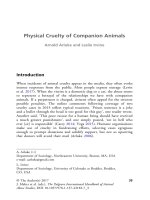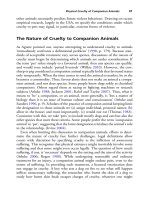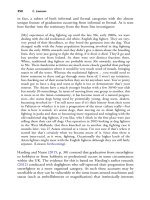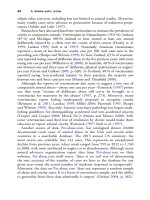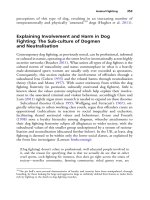The palgrave international handbook of a 188
Bạn đang xem bản rút gọn của tài liệu. Xem và tải ngay bản đầy đủ của tài liệu tại đây (26.89 KB, 1 trang )
Slaughterhouses
181
Organization of the United Nations for 2003, which conservatively estimated that 53 billion land animals were slaughtered annually worldwide.
According to the AKC site:
These numbers do NOT include the many millions of animals killed each
year in vivisection laboratories. They do NOT include the millions of dogs
and cats killed in animal shelters every year. They do NOT include the
animals who died while held captive in the animal-slavery enterprises of
circuses, rodeos, zoos, and marine parks. They do NOT include the animals
killed while pressed into such blood sports as bullfighting, cockfighting,
dogfighting, and bear-baiting, nor do they include horses and greyhounds
who were exterminated after they were no longer deemed suitable for racing.
(AKC n.d.)
Slaughterhouse violence is rising. According to the FAO (2002, p. 19):
Between 1964–66 and 1997–99, per capita meat consumption in developing
countries rose by 150 percent, and that of milk and dairy products by
60 percent. By 2030, per capita consumption of livestock products could rise
by a further 44 percent. As in the past, poultry consumption will grow fastest.
The report also notes ‘An increasing share of livestock production will
probably come from industrial enterprises. In recent years production
from this sector has grown twice as fast as that from more traditional
mixed farming systems and more than six times faster than from grazing
systems’ (p. 6). In a report by the Australian Institute of Health and
Welfare (AIHW 2012), for example, the rate of Australian meat consumption is estimated to be almost three times higher than the rest of the world.
This is not likely to decrease given the official endorsement of meat-eating
by governments who still advise that the daily recommended intake for
adults and children includes ‘lean meat, fish, poultry and/or alternatives’
(AIHW 2012, p. 139).
Ironically, it is the prevalence—or commonness—of the institutionally
sanctioned slaughter of animals that poses one of the most important
challenges to ending the killing. Rather than compel people to take the
issue more seriously, the scale of the violence complicates matters, making
it for many too large and confronting to face. This is even more confronting if other forms of socially sanctioned slaughter were included, such as
the culling of animals in the name of animal management, such as sharks
(see for instance, Small 2014), the ‘commercial harvesting’ of kangaroos
